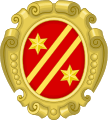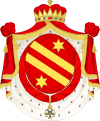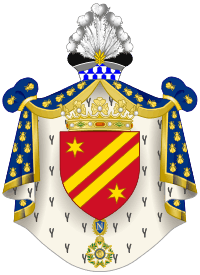Lucien Bonaparte
| Lucien Bonaparte | |
|---|---|
| 1st Prince of Canino and Musignano | |
 Portrait by François-Xavier Fabre | |
| Prince of Canino | |
| Reign | 18 August 1814 – 29 June 1840 |
| Successor | Charles Lucien Bonaparte |
| Prince of Musignano | |
| Reign | 21 March 1824 – 29 June 1840 |
| Successor | Charles Lucien Bonaparte |
| Born |
21 May 1775 Ajaccio, Corsica, France |
| Died |
29 June 1840 (aged 65) Viterbo, Papal States |
| Spouse |
Christine Boyer Alexandrine de Bleschamp |
| Issue |
Charlotte Bonaparte, Princess Mario Gabrielli Victoire Bonaparte Christine Bonaparte, Lady Stuart Charles Lucien Bonaparte, 2nd Prince of Canino and Musignano Letizia Bonaparte, Lady Thomas Wyse Joseph Lucien Bonaparte Jeanne Bonaparte, Marchessa Honorato Honorati Paul Marie Bonaparte Louis Lucien Bonaparte Pierre Napoleon Bonaparte Antoine Bonaparte Alexandrine Bonaparte, Countess di Laviano Constance Bonaparte |
| House | Bonaparte |
| Father | Carlo Buonaparte |
| Mother | Letizia Ramolino |
| Religion | Roman Catholicism |
Lucien Bonaparte, Prince Français, 1st Prince of Canino and Musignano (born Luciano Buonaparte; 21 May 1775 – 29 June 1840), was a French statesman, the third surviving son of Carlo Buonaparte and his wife Letizia Ramolino.
Lucien was a younger brother of Joseph and Napoleon Bonaparte, and an older brother of Elisa, Louis, Pauline, Caroline and Jérôme Bonaparte. Lucien held genuinely revolutionary views, which led to an often abrasive relationship with his brother Napoleon, who seized control of the French government in 1799, when Lucien was 24.[1]
Life and career
Lucien Bonaparte's rise to power, unlike his younger brothers, was not based on familial connections or nepotism. This caused friction between him and his brother Napoleon I, later on.
Youth
Lucien was born in Ajaccio, Corsica in 1775, and was educated in mainland France, at the College d'Autun, the military school in Brienne, and at seminary in Aix-en-Provence. In 1769 the Corsican Republic had been conquered by French forces and annexed into France. Lucien's father Carlo Bonaparte had been a strong supporter of Corsican patriots under Pasquale Paoli, but later switched to become a supporter of French rule.
Revolutionary activities
Lucien returned to Corsica at the outbreak of the French Revolution in 1789 and became an outspoken speaker in the Jacobin Club at Ajaccio, where he renamed himself "Brutus". An ally of Maximilien Robespierre during the Reign of Terror, he was briefly imprisoned (at Aix-en-Provence) after the coup of 9 Thermidor.
President of the Council of Five Hundred
As president of the Council of Five Hundred — which he removed to the suburban security of Saint-Cloud — Lucien Bonaparte was crucial with a combination of bravado and disinformation to the coup d'état of 18 Brumaire (date based on the French Revolutionary Calendar) in which General Bonaparte overthrew the government of the Directory to replace it by the Consulate. Lucien mounted a horse and galvanized the grenadiers by pointing a sword at his brother and swearing to run him through if he ever betrayed the principles of Liberté, égalité, fraternité. The following day Lucien arranged for Napoleon's formal election as First Consul.
Diplomacy
Napoleon made him Minister of the Interior under the Consulate, which enabled Lucien to falsify the results of the plebiscite but which brought him into competition with Joseph Fouché, the chief of police, who showed Napoleon a subversive pamphlet that was probably written by Lucien, and effected a breach between the brothers. Lucien was sent as ambassador to the court of Charles IV of Spain, (November, 1800), where his diplomatic talents won over the Bourbon royal family and, perhaps as importantly, the minister Manuel de Godoy.[1]
Falling out with the Emperor
Though he was a member of the Tribunat in 1802 and was made a senator of the First French Empire, Lucien came to oppose many of Napoleon's imperial ideas, particularly the marriage of convenience planned for him to a Bourbon Spanish princess, the Queen of Etruria. In 1804, spurning imperial honors, he went into self-imposed exile, living initially in Rome, where he bought the Villa Rufinella in Frascati.
Later years
.jpg)
In 1809, Napoleon increased pressure on Lucien to divorce his wife and return to France, even having their mother write a letter encouraging him to abandon her and return. With the whole of the Papal States annexed to France and the Pope imprisoned, Lucien was a virtual prisoner in his Italian estates, requiring permission of the Military Governor to venture off his property. He attempted to sail to the United States to escape his situation but was captured by the British. When he disembarked in England, he was greeted with cheers and applause by the crowd, which saw him as anti-Napoleon.
The government permitted him to settle comfortably with his family at Ludlow, and later the country house at Thorngrove in Worcestershire, where he worked on a heroic poem on Charlemagne. Napoleon, believing Lucien had deliberately gone to Britain and thus a traitor, had Lucien omitted from the Imperial almanacs of the Bonapartes from 1811 onward.
Lucien returned to France following his brother's abdication in April 1814. He continued to Rome where on 18 August 1814 he was made Prince of Canino, Count of Apollino, and Lord of Nemori by Pope Pius VII and Prince of Musignano on 21 March 1824 by Pope Leo XII.[2]
In the Hundred Days after Napoleon's return from exile at Elba, Lucien rallied to the imperial cause. His brother made him a French Prince and included his children into the Imperial Family, but this was not recognized by the Bourbons after Napoleon's second abdication. Subsequently Lucien was proscribed at the Restoration and deprived of his fauteuil at the Académie française. In 1836 he wrote his Mémoires. He died in Viterbo, Italy, on 29 June 1840, of stomach cancer, the same disease that claimed his father, his sister Pauline and his brother Napoleon.[2]
Academic activities
Lucien Bonaparte was the inspiration behind the Napoleonic reconstitution of the dispersed Académie française in 1803, where he took a seat. He collected paintings in la maison de campagne at Brienne, was a member of Jeanne Françoise Julie Adélaïde Récamier's salon and wrote a novel, La Tribu indienne. He was an amateur archeologist, establishing excavations at his property in Frascati which produced a complete statue of Tiberias, and at Musignano which rendered a bust of Juno. Bonaparte owned a parcel which had once formed part of Cicero's estate called Tusculum, and was much given to commenting on the fact. In 1825, Bonaparte excavated the so-called Tusculum portrait of Julius Caesar at the Tusculum's forum.[3]
Marriages and children
His first wife was his landlord's daughter, Christine Boyer (3 July 1771 – 14 May 1800),[4] the illiterate sister of an innkeeper of Saint-Maximin-la-Sainte-Baume, and by her he had four children:
- Filistine Charlotte (28 November 1795 – 6 May 1865), married Prince Mario Gabrielli.
- Stillborn son (13 March 1796).
- Victoire Gertrude (born and died 9 July 1797).
- Christine Egypte (18 October 1798 – 1847), married firstly Count Arvid Posse (divorced) and secondly Lord Dudley Stuart.
His second wife was Alexandrine de Bleschamp (23 February 1778 – 12 July 1855), widow of Hippolyte Jouberthon, known as "Madame Jouberthon",[5] and by her he had ten children:
- Charles Lucien Bonaparte (24 May 1803 – 29 July 1857), the naturalist and ornithologist.
- Letizia (1 December 1804 – 15 March 1871), married Sir Thomas Wyse.
- Joseph (14 June 1806 – 15 August 1807).
- Jeanne (22 July 1807 – 22 September 1829), married Marquis Honoré Honorati.
- Paul Marie (3 November 1809 – 7 September 1827).
- Louis Lucien (4 January 1813 – 3 November 1891).
- Pierre Napoleon (11 October 1815 – 7 April 1881).
- Antoine (31 October 1816 – 28 March 1877), married Marie-Anne Cardinali, without issue.
- Marie Alexandrine (10 October 1818 – 20 August 1874), married Vincenzo Valentini, Count di Laviano.
- Constance (30 January 1823 – 5 September 1876), a nun.
Coat of arms
 Coat of arms of the Bonaparte family
Coat of arms of the Bonaparte family Coat of arms as Prince of Canino and Musignano
Coat of arms as Prince of Canino and Musignano Coat of arms as a French prince during the Hundred Days
Coat of arms as a French prince during the Hundred Days
Ancestry
| Ancestors of Lucien Bonaparte | ||||||||||||||||||||||||||||||||||||||||||||||||||||||||||||||||||||||||||||||||||||||||||||||||||||||||||||||||||||||||||||||||||||||||||||||||||||||||||||||||||||||||||||||||||||||||||||||||||||||||||||||||||||||||||||||||||||||||||||||||||||||||||||||||||||||||||||||||||||||||||||||||||||||||||||||||||||||||||||||||||||||||||||||||||||||||||||||||||||||||||||||||||||||||||||||||||||||||||||||||||||||||||||||||||||||||||||||||||||||||||||||||||||||||||||||||||||||
|---|---|---|---|---|---|---|---|---|---|---|---|---|---|---|---|---|---|---|---|---|---|---|---|---|---|---|---|---|---|---|---|---|---|---|---|---|---|---|---|---|---|---|---|---|---|---|---|---|---|---|---|---|---|---|---|---|---|---|---|---|---|---|---|---|---|---|---|---|---|---|---|---|---|---|---|---|---|---|---|---|---|---|---|---|---|---|---|---|---|---|---|---|---|---|---|---|---|---|---|---|---|---|---|---|---|---|---|---|---|---|---|---|---|---|---|---|---|---|---|---|---|---|---|---|---|---|---|---|---|---|---|---|---|---|---|---|---|---|---|---|---|---|---|---|---|---|---|---|---|---|---|---|---|---|---|---|---|---|---|---|---|---|---|---|---|---|---|---|---|---|---|---|---|---|---|---|---|---|---|---|---|---|---|---|---|---|---|---|---|---|---|---|---|---|---|---|---|---|---|---|---|---|---|---|---|---|---|---|---|---|---|---|---|---|---|---|---|---|---|---|---|---|---|---|---|---|---|---|---|---|---|---|---|---|---|---|---|---|---|---|---|---|---|---|---|---|---|---|---|---|---|---|---|---|---|---|---|---|---|---|---|---|---|---|---|---|---|---|---|---|---|---|---|---|---|---|---|---|---|---|---|---|---|---|---|---|---|---|---|---|---|---|---|---|---|---|---|---|---|---|---|---|---|---|---|---|---|---|---|---|---|---|---|---|---|---|---|---|---|---|---|---|---|---|---|---|---|---|---|---|---|---|---|---|---|---|---|---|---|---|---|---|---|---|---|---|---|---|---|---|---|---|---|---|---|---|---|---|---|---|---|---|---|---|---|---|---|---|---|---|---|---|---|---|---|---|---|---|---|---|---|---|---|---|---|---|---|---|---|---|---|---|---|---|---|---|---|---|---|---|---|---|---|---|---|---|---|---|---|---|---|---|---|---|---|---|---|---|---|---|---|---|---|---|---|---|---|---|---|---|---|---|---|---|---|---|---|---|---|---|---|---|---|---|---|---|---|---|---|---|---|---|---|---|---|---|---|---|---|---|---|---|---|---|---|---|---|---|---|---|
| ||||||||||||||||||||||||||||||||||||||||||||||||||||||||||||||||||||||||||||||||||||||||||||||||||||||||||||||||||||||||||||||||||||||||||||||||||||||||||||||||||||||||||||||||||||||||||||||||||||||||||||||||||||||||||||||||||||||||||||||||||||||||||||||||||||||||||||||||||||||||||||||||||||||||||||||||||||||||||||||||||||||||||||||||||||||||||||||||||||||||||||||||||||||||||||||||||||||||||||||||||||||||||||||||||||||||||||||||||||||||||||||||||||||||||||||||||||||
References
- 1 2 Schom, Alan, Napoleon Bonaparte, (HarperCollins Publishers, 1997), pp 237, 238.
- 1 2 Stroud, Patricia Tyson, The Emperor of Nature: Charles-Lucien Bonaparte and his world, (University of Pennsylvania Press, 2000), pp.21; 160.
- ↑ The J. Paul Getty Museum (1987). Ancient Portraits in the J. Paul Getty Museum: Volume 1. Getty Publications. p. 24. ISBN 0892360712.
- ↑ de Bourrienne, Louis Antoine Fauvelet and Ramsay Weston Phipps, Memoirs of Napoleon Bonaparte, Vol.1, (Charles Scribner's Sons:New York, 1895), 100.
- ↑ Atteridge, Andrew Hilliard and Jérôme Bonaparte, Napoleon's brothers, (Methuen and Co.:London, 1909), 98.
External links
| Wikimedia Commons has media related to Lucien Bonaparte. |
- Académie Francaise: Les Immortels: (in French)
- Lucien Bonaparte
| Lucien Bonaparte Born: 21 May 1775 Died: 29 June 1840 | ||
| Titles of nobility | ||
|---|---|---|
| New title | Prince of Canino 1814–1840 |
Succeeded by Charles Lucien Bonaparte |
| Prince of Musignano 1824–1840 | ||
| Ancestors of Lucien Bonaparte | |||||||||||||||||||||||||||||||||||||||||||||||||||||||||||||||||||||||||||||||||||||||||||||||||||||||||||||||||||||||||||||||||||||||||||||||||||||||||||||||||||||||||||||||||||||||||||||||||||||||||||||||||||||||||||||||||||||||||||||||||||||||||||||||||||||||||||||||||||||||||||||||||||||||||||||||||||||||||||||||||||||||||||||||||||||||||||||||||||||||||||||||||||||||||||||||||||||||||||||||||||||||||||||||||||||||||||||||||||||||||||||||||||||||||||
|---|---|---|---|---|---|---|---|---|---|---|---|---|---|---|---|---|---|---|---|---|---|---|---|---|---|---|---|---|---|---|---|---|---|---|---|---|---|---|---|---|---|---|---|---|---|---|---|---|---|---|---|---|---|---|---|---|---|---|---|---|---|---|---|---|---|---|---|---|---|---|---|---|---|---|---|---|---|---|---|---|---|---|---|---|---|---|---|---|---|---|---|---|---|---|---|---|---|---|---|---|---|---|---|---|---|---|---|---|---|---|---|---|---|---|---|---|---|---|---|---|---|---|---|---|---|---|---|---|---|---|---|---|---|---|---|---|---|---|---|---|---|---|---|---|---|---|---|---|---|---|---|---|---|---|---|---|---|---|---|---|---|---|---|---|---|---|---|---|---|---|---|---|---|---|---|---|---|---|---|---|---|---|---|---|---|---|---|---|---|---|---|---|---|---|---|---|---|---|---|---|---|---|---|---|---|---|---|---|---|---|---|---|---|---|---|---|---|---|---|---|---|---|---|---|---|---|---|---|---|---|---|---|---|---|---|---|---|---|---|---|---|---|---|---|---|---|---|---|---|---|---|---|---|---|---|---|---|---|---|---|---|---|---|---|---|---|---|---|---|---|---|---|---|---|---|---|---|---|---|---|---|---|---|---|---|---|---|---|---|---|---|---|---|---|---|---|---|---|---|---|---|---|---|---|---|---|---|---|---|---|---|---|---|---|---|---|---|---|---|---|---|---|---|---|---|---|---|---|---|---|---|---|---|---|---|---|---|---|---|---|---|---|---|---|---|---|---|---|---|---|---|---|---|---|---|---|---|---|---|---|---|---|---|---|---|---|---|---|---|---|---|---|---|---|---|---|---|---|---|---|---|---|---|---|---|---|---|---|---|---|---|---|---|---|---|---|---|---|---|---|---|---|---|---|---|---|---|---|---|---|---|---|---|---|---|---|---|---|---|---|---|---|---|---|---|---|---|---|---|---|---|---|---|---|---|---|---|---|---|---|---|---|---|---|---|---|---|---|---|---|---|---|---|---|---|---|---|---|---|
| |||||||||||||||||||||||||||||||||||||||||||||||||||||||||||||||||||||||||||||||||||||||||||||||||||||||||||||||||||||||||||||||||||||||||||||||||||||||||||||||||||||||||||||||||||||||||||||||||||||||||||||||||||||||||||||||||||||||||||||||||||||||||||||||||||||||||||||||||||||||||||||||||||||||||||||||||||||||||||||||||||||||||||||||||||||||||||||||||||||||||||||||||||||||||||||||||||||||||||||||||||||||||||||||||||||||||||||||||||||||||||||||||||||||||||
2.svg.png)
.svg.png)
